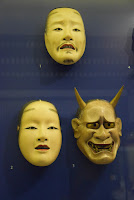(...)
Standing Buddha - sandstone - AD 450-600 (Gupta Dinasty).
The figure embodies the classic style of the Gupta Dinasty associated with the monastic centre of Sarnath. Features of the style include the monastic robe that clings tightly to a slightly swaying body and the serene introspective expression of the face. Two devotees kneel at either side of the Buddha's feet.
Figure of Samurai (1860) dressed in armour (1800).
The life-size human figure with its highly realistic features is one of the known traditional "living dolls" used both in Japan and in international exhibitions abroad where they featured in dramas about Japanese life and history.
No masks of a young woman, a young nobleman and a demon - carved and painted cypress - About 2000
Masks are used to create a mood of yugen, a Japanese aesthetic concept suggestive of sadness, mystery, elegance and calm.
Processional mask of Bodhisattva - Carved, lacquered and gilded wood, with painted details -1400-1500.
In Buddhism, a Bodhisattva is an enlightened being who helps others on their path to enlightenment. This mask would have been worn along with sumptuous robes for a religious ceremony in which monks processed around the buildings and grounds of a temple complex. This created the effect of temple sculptures coming to life and served as a reminder of the world to come.


The Nativity - cast of Antonio Rossellino - About 1450-75.
Carving the marble roundel was a feat of great skill, with its depth, perspective and multiple figures. The 19th-century plaster copy was also a technical challenge. Rosselino's scene is richly pictorial and narrative, and reflects the influence of contemporary painters.



David - cast of Michelangelo - 1501-4
David, slayer of the giant Goliah was a symbol of civic freedom for the Florentine Republic.Michaelangelo carved his David from a single block of marble. It was placed outside the Palazzo Vecchio until 1873. The marble copy that replaced it shortly aterwards still stands there today.
The Visitation - cast of Luca della Robia - Before 1445.
The Virgin, pregnant with Christ Child embraces the kneeling figure of her older cousin St. Elizabeth, who is pregnant with St. John the Baptist. Luca della Robia's original figures in Pistola are glazed white with colour and gilding. Although plainer, the plaster copy nonetheless evokes the emotional scen and the expressive figures.

Pulpit - cast of Nicola Pisano - 1260.
The cast reproduces a richly carved pulpit, the most celebrated work of Nicola Pisano. It does not reproduce the colour of the original - green and red marble for the columns and naturalistic colour in the carved scenes of the life of Christ. Pisano was an important forerunner of Italian Renaissance sculpture because of his pioneering use of classical themes, for which the pulpit was especially admired.
We stopped several times on the ground level side corridors to admire the mosaic paintings hanging on the walls, as we were on our way to the inner garden-like pavilion, where a few children played on its pond under their parents' supervision.
We sat there for a while before heading back in to continue our visit still on the groundfloor. though this time on the side galleries.



Sunna - Portland stone - 1728-30 by John Michael Rysbrack.
Sunna is from a unique series of Saxon Gods that Lord Cobham commissioned for his gardens at Stowe. Each God was traditionally associated with a day of the week, with Sunna representing Sunday. This figure is siad to have been lost for many years, having been only rediscovered in 1996.

Valour and Cowardice - 1857-66 by Alfred Stevens.
This is a full-size model for one of the groups on the bronze monument to the Duke of Wellington in St. Paul's Cathedral - a work that occupied much of Stevens' career. Here Valour crushes Cowardice.

Peasant woman nursing a baby - Terracotta - 1873 - Aimé-Jules Dalou.
Dalou is said to have spent seven years in London and during this time produced many intimate domestic scenes, He explored this composition in numerous versions using various media and experimenting with different sizes.
Despite not having gone beyond the groundfloor (because of my tempoorary physical limitation) we were both very happy to have selected this and no other Museum. We did enjoy every minute of it.

















No comments:
Post a Comment